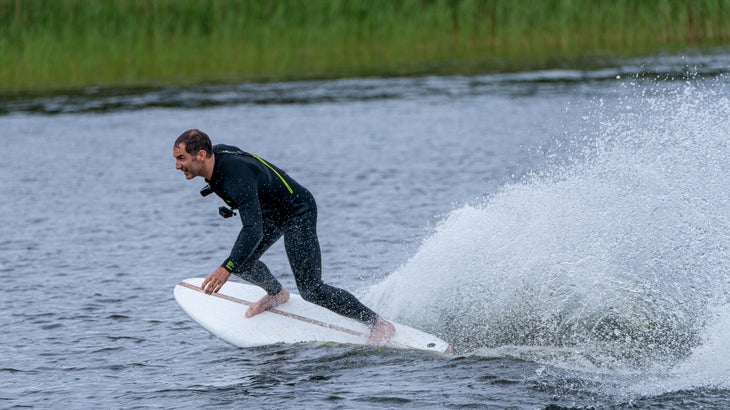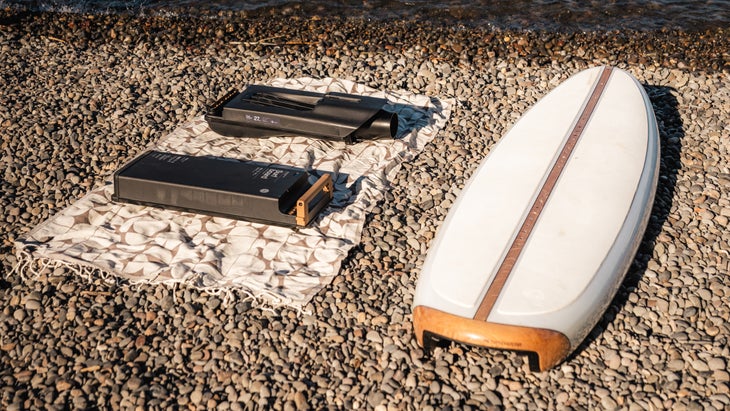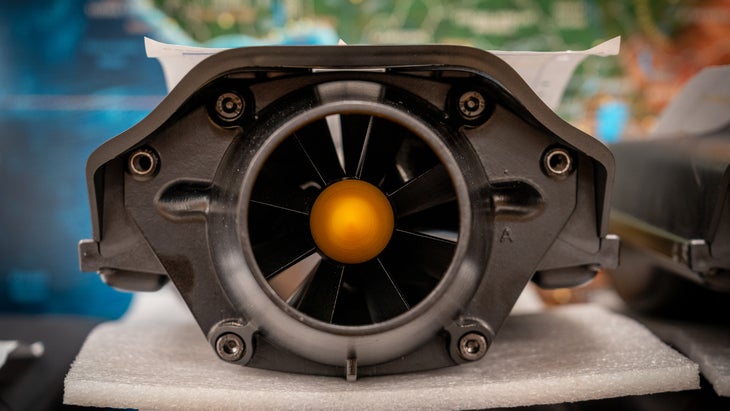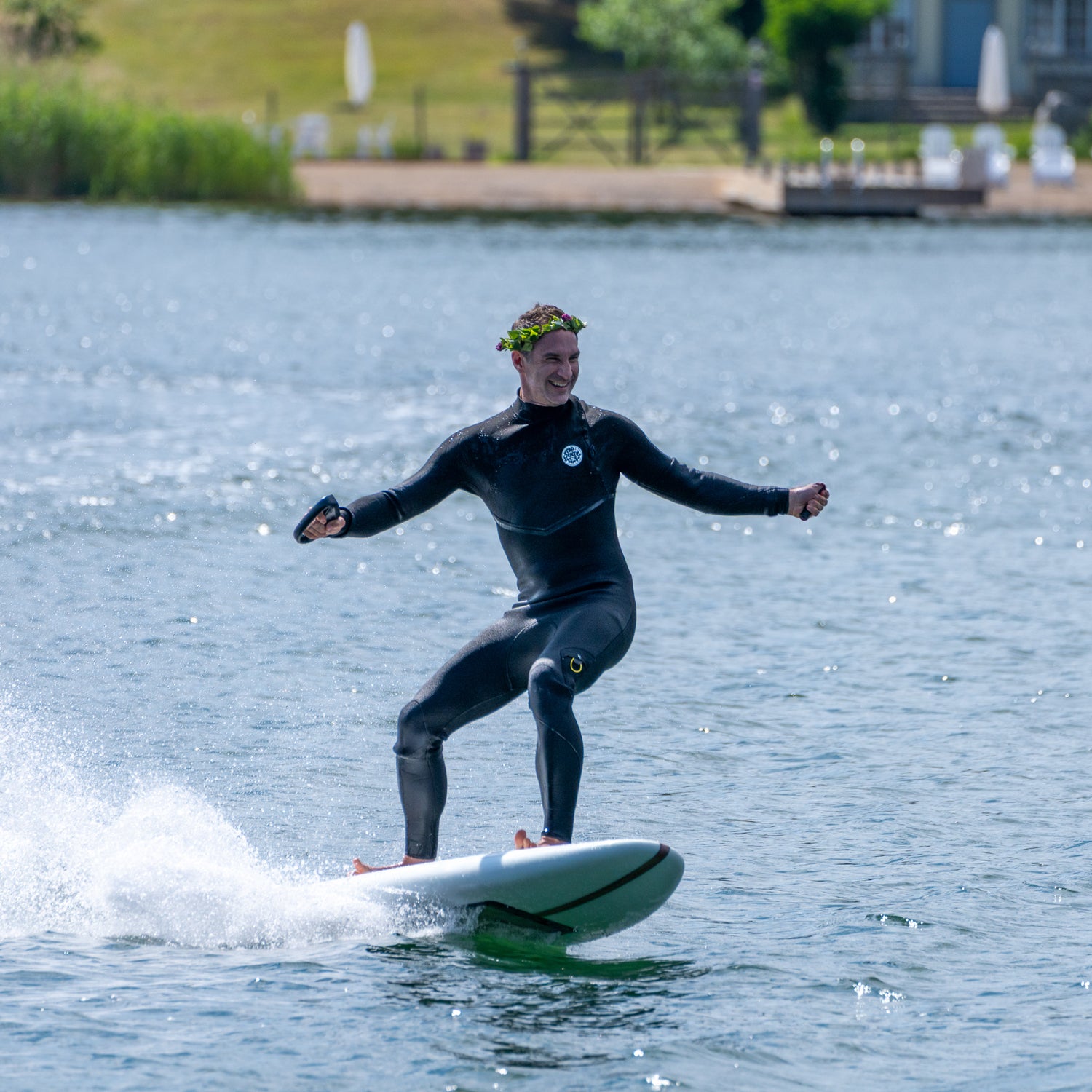Surfing is addictive. Once it clicks, you feel like you’re flying over the surface of water. The only thing is, you need a wave to do it. For me, wakesurfing doesn’t scratch the itch, and while mechanical wave pools exist, they aren’t exactly cheap or ubiquitous yet. Enter the Lind Canvas, an insanely over-engineered, high-powered electric surfboard that delivers surf-like thrills in any reasonably-sized body of water at speeds of up to 35 miles per hour. And you only need to sell one or two critical organs to be able to afford one!
It sounded like something I needed to test for myself, so I traveled to Stockholm, Sweden, where the company is based, to check them out.
Two things that are important to emphasize right away: First, these are surfboards, not e-foils, and second, these boards are built for flat water, not waves. It is designed to put the power of a wave into the board itself and recreate the feeling of riding waves in places where there are no waves. The idea of some rich scrubs trying to poach waves from normal paddle-surfers on these 80-pound rockets in a crowded line-up is frankly terrifying.

The Lind Canvas surfboard comes in two sizes: a 6’3” shortboard and a 6’9” mid-length. From the top they look like standard surfboards, though they are a bit wider, and at 6” thick they are more than twice as thick as your standard board to accommodate the special sauce. In the board’s belly, a hollow bay holds the battery and engine. Every single component, aside from the individual battery cells themselves (which are the same lithium cells you find in high-end electric cars), has been meticulously designed in-house. The result? A sleek 3.1 kilowatt-hour battery pack and an astonishing 28 horsepower engine.
If that sounds like a terrifying amount of power to have under your feet, you would be correct. It is one of the most power-dense platforms ever created—double the power density of a Tesla Model S. It’s the kind of engineering you expect from something military grade, not from a surfboard purely for recreation.

Evolution of the Electric Surfboard
This is not the world’s first electric surfboard. This isn’t even the first electric surfboard from Alexander Lind, the Swedish co-founder from whom Lind gets its name. His first boards under the company Radinn were heavy and wide, making them extremely difficult to get on rail and carve with. In other words, they felt more like a small boat you stood up on rather than a board you surfed.
But Radinn enjoyed some early success. In 2014, Lind took the company’s first prototype and rode it off a 9-foot-tall waterfall for a promo video. The video cuts away just as Lind and the board touch down in the water, conveniently omitting that the thing snapped in half upon impact. It didn’t matter, though. The video went viral, and despite the Radinn boards’ shortcomings, they sold about 1,000 units over the years. So, when Alex was looking to start fresh, he thought, “Why not do it again—recreate the viral enthusiasm—but do it right this time?”
Together with his two new co-founders—Anders Dellson (CEO) and Mattias Söderhielm (CTO/COO)—Lind traveled to the Maldives. They took surf lessons during the day and, in the evenings, worked on a business plan for what would become Lind Surf. Upon returning to Stockholm, they got to work assembling a production team of absolute killers, including tapped Swedish materials and production specialists and poached experienced Heart Aerospace engineers who had previously worked at NASA on Mars rovers.
While Radinn had started with the jet and tried to build a board around it, Lind started with a surfboard. They worked with shaper Sam Bass of, who is known for making highly-customized boards, refining their design for a shortboard that would have the planning, grip, and responsiveness of a real board while also being thick enough to house the payload that would power it.

Design Features of the Lind Canvas
The Canvas design is modular, separated into three pieces. There’s the board itself, which features a thick oak stringer with two-dozen screw holes for the included foot-straps. It’s light enough that it can be lifted with one hand, but it also comes with a canvas bag with a padded shoulder strap. Its largest, flattest surface has an aluminum panel that becomes the bottom of the board and acts as a heat-sink in the water, keeping the batteries healthier. The heaviest component, a 37-pound battery, can be carried in the included backpack.
Also tucked away into the backpack is the jet engine. Rather than using one larger motor, which would have been bulbous and impacted the board’s hydrodynamics, they split the job and use two motors in parallel. To achieve this, Lind made a mad-scientist-level, multi-stage gearbox with bespoke gears that transfers maximum torque to the single impeller in the middle without shearing the gears’ teeth off. Like everything else, that impeller is made in-house, utilizing computational fluid dynamics to develop the correct attributes.
A wireless remote control, which uses a simple trigger to control acceleration and has a four-way D-pad on top to power on/off, pair with the board, and adjust the power-level. A bright LCD displays your current power level and remaining battery percentage (but not your speed in mph or kph). For the geeks thinking all this must take an awful lot of programming, that would be correct. The system has six microcontrollers that manage everything from speed to battery maintenance. It even has 4G telemetry so it can share critical information with you. For instance, if you accidentally leave your battery in a hot car with the windows up, it will send a notification to your phone before heat damages the electronics or the whole thing bursts into flames. It really is a staggering amount of engineering, and yes, the price tag reflects that, but we’ll get to that in a minute.
The charger is pretty slick, too. It looks like something you’d plug into your electric car, but it uses a standard electrical outlet and charges shockingly fast. A battery can fully recharge in an hour. Considering each battery gives you about 45 minutes of run time (shorter if you crank up the power level), that really maximizes the amount of time you get to spend in the water.
It’s also worth noting that you can customize the board with the paint job, or specific materials, like a wooden inlay on the deck. You can even work with the shaper of your choice, as long as they can make a design that will fit the electronics payload.
Testing the Lind Canvas
None of that engineering matters if the thing doesn’t work well. Fortunately, I can confirm that it is indeed obscenely fun. The backpack and bag system is designed so you don’t need a boat ramp or a dock, or anything like that. You can even hike it down to a remote lake, river, or beach, though you probably wouldn’t want to hike too far as the whole system weighs about 77 pounds. Once you’ve found your spot, you turn the board onto its back, latch in the jet pack and battery, add the fin, flip it into the water, and pair it with the remote. The whole assembly is toolless and takes just a minute or two.
Then you put your belly on the board, point it in a safe direction, and squeeze the trigger. For first timers, it’s recommended that you start at power level 4 or 5 (out of a maximum of 15). Within seconds you’ll be hydroplaning, dragging your legs behind you, and grinning like an idiot. As with real surfing, the transition from prone to standing is one of the trickiest bits, but here you aren’t falling down the face of a wave with just seconds to get to your feet. On a Canvas board, you effectively have an unlimited amount of time to get your balance and work your way to vertical, which still takes time to figure out, but as with a bike, the faster you’re going the more stable it is.
In Stockholm, I test the board on a number of different lakes, rivers, and bays, in fresh water, salt water, and brackish, sometimes with rolling hills in the distance, sometimes in front of massive hotels or vacation homes. As someone who has been surfing for the last 20 years, I came in with high hopes and low expectations, but I was thrilled to make it to my feet on the first try. In fact, every single person in our small group (most of whom had never surfed) all made it to their feet relatively quickly, and then everyone just started ripping. I was able to really lean into my turns, feeling the G-forces pull my feet into the deck of the board, while a rooster-tail of water sprayed off the back. While the 6’9” mid-length board is more stable for getting up, the 6’3” shortboard is much easier to turn. On smooth water, I turned it up to power-level 10. I’d estimate I was going somewhere between 25 and 30 miles per hour, noticeably faster than the waist to head-high waves I typically surf in California. The heaviness of the board helps dampen some chop in the water, but you really feel those bumps at speed, including when you make a big turn and ride over your own wake. I had no shortage of spectacular wipeouts.
While it does indeed feel a lot like surfing, it’s not a perfect analog. The weight distribution is different and learning to carve with motorized power takes some getting used to.There’s certainly a learning curve, and I only scratched the surface. Once you figure it out, though, you can mix in some flair. LLind’s team riders, none of whom are paddle surfers, were able to cross-step their way up to the nose and hang-five, demonstrating a level of finesse that only comes with time and practice.
For all its speed, because it’s electric, it’s also much quieter than something like a jet ski, so the sounds of your uncontrolled whoops echo unimpeded. Tourists who saw or heard me coming were quick to pull out their phones and snap pics of this strange watercraft zipping by them.

Safety Notes
As good of a time as this board is, there’s still plenty of room for safety improvement. While a normal surfboard has an ankle leash to keep your board nearby, that’s not an option here. For now, once the controller hits the water and breaks the radio signal, the board’s motor stops. But if you neglect to release the trigger as you fall, then that board will continue on at speed and with inertia, which means you might have to swim a good 50 yards to retrieve it—or it could crash into a river bank, boat, or person.
Thus, you’re advised to let go of the throttle the moment you realize you’re falling. But that introduces another problem: the drag of the water slows the board down faster than your body, sending you flying off the front, which is extra scary because then you could be run over by the board or slashed by the fin. Thankfully, neither of those things happened to me or anybody in my group, but a couple of times were too close for comfort. Lind is currently testing different solutions for both of these issues.

Sticker Shock
If this all sounds like a ton of fun and you’re wondering what the catch is, well, it costs $25,000. You could buy a mid-range 2025 Toyota Corolla for that. Hell, you could buy three new, entry-level jet skis, which would carry six times as many people and are more versatile water vehicles. So it’s not an “it’s not for everybody” thing as much as it’s an “it’s for very few people who can afford it” thing.
That said, I actually hate jet skiing, and I feel indifferent about wakesurfing, but I loved this board. If I wanted a recreational water vehicle for my lake house, I would choose a Lind Surf board over a jet ski in a heartbeat. It’s such a unique feeling. It’s quiet and sleek, and the sheer amount of power it packs is unlike anything I’ve ever experienced. The only problem is I don’t have a lake house or $25,000 to drop on a surfboard. For those that do, this board offers a truly unique experience on the water, and it’s a ripping good time. If you can find a way to demo one for a day, you will not regret it.


